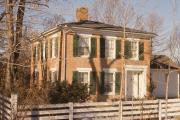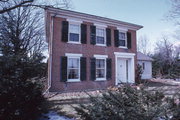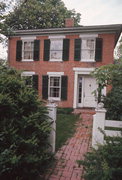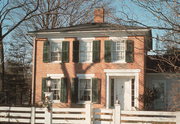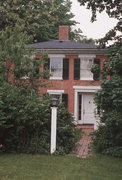Property Record
11219 N Webster (AKA NW CORNER OF WEBSTER AND ROCK)
Architecture and History Inventory
| Historic Name: | LOVEJOY-DUNCAN HOUSE |
|---|---|
| Other Name: | House Next Door |
| Contributing: | Yes |
| Reference Number: | 71477 |
| Location (Address): | 11219 N Webster (AKA NW CORNER OF WEBSTER AND ROCK) |
|---|---|
| County: | Rock |
| City: | |
| Township/Village: | Porter |
| Unincorporated Community: | COOKSVILLE |
| Town: | 4 |
| Range: | 11 |
| Direction: | E |
| Section: | 6 |
| Quarter Section: | SE |
| Quarter/Quarter Section: | SW |
| Year Built: | 1848 |
|---|---|
| Additions: | |
| Survey Date: | 1977 |
| Historic Use: | house |
| Architectural Style: | Greek Revival |
| Structural System: | |
| Wall Material: | Brick |
| Architect: | |
| Other Buildings On Site: | |
| Demolished?: | No |
| Demolished Date: |
| National/State Register Listing Name: | Cooksville Historic District - Boundary increase |
|---|---|
| National Register Listing Date: | 9/17/1980 |
| State Register Listing Date: | 1/1/1989 |
| National Register Multiple Property Name: | Multiple Resources of Cooksville |
| Additional Information: | A 'site file' exists for this property. It contains additional information such as correspondence, newspaper clippings, or historical information. It is a public record and may be viewed in person at the Wisconsin Historical Society, State Historic Preservation Office. Square, two story, vermillion brick house with a hip roof, bulit in 1848 in a Federalist-Greek Revival style. It is one of the finest houses in the town. Photo 19/5 is a barn - separate record. Arranged around a common like a New England village, Cooksville is a well-preserved nineteenth-century community. Founder John Cook laid out the initial 1842 village in an “oak opening”--a park-like setting of widely spaced oak trees, growing in the tallgrass prairie. The prairie gave way to fields of wheat, then to dairy and tobacco farms. Nearby Badfish Creek supplied water power for Cooksville’s mills. The transplanted New Englanders and New Yorkers who settled the area in the 1840s and 1850s built their houses of vermilion brick in simplified versions of the popular Gothic Revival and Greek Revival styles. A number were the work of Benjamin Hoxie, a carpenter and self-taught architect, and John Willis Fisher Jr., a local carpenter. At the southwest edge of the commons, the Daniel Lovejoy-Henry Duncan House, was built in the late 1840s in the Greek Revival style. Two stories tall with a hipped roof, in the characteristic Greek Revival manner, the building has its entry flanked by sidelights and recessed within a simple architrave molding. Six-over-six windows with flat stone lintels complete the composition. Daniel Lovejoy was a leading developer of Cooksville who built several houses in the area as speculative ventures. In 1852 he sold this one to Henry Duncan, who lived here until 1875 and added the one-story clapboard wing sometime before he left. |
|---|---|
| Bibliographic References: | (A) PERRIN 67, PP. 65-66. (B) PERRIN 62, PP. 56-57. (C) PERRIN 60, P. 13. (D) STOUGHTON COURIER HUB 9/12/1996. (E) BUILDINGS OF WISCONSIN MANUSCRIPT. Perrin, Richard W. E., Historic Wisconsin Architecture, First Revised Edition (Milwaukee, 1976). |
| Wisconsin Architecture and History Inventory, State Historic Preservation Office, Wisconsin Historical Society, Madison, Wisconsin |

